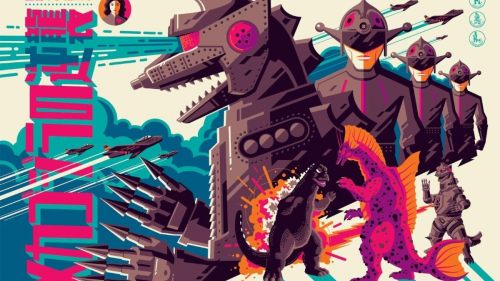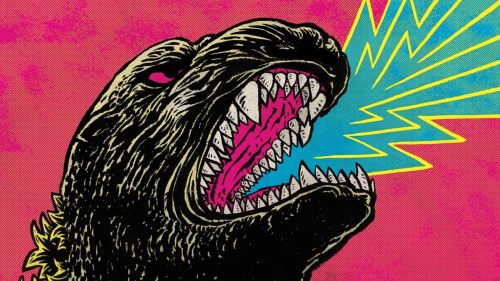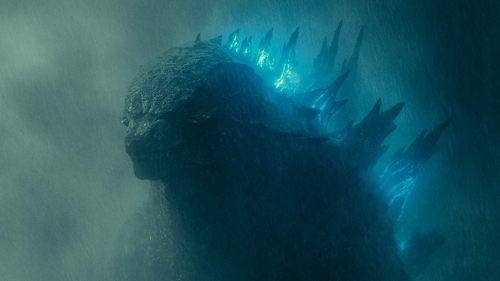KONG: SKULL ISLAND - A Big, Awesome Anti-War Movie
King Kong and Godzilla are inexorably connected icons. Reflections of the various goings on of the Western and Eastern worlds, from colonialism and slavery to war and nuclear weapons to everything else in between, not to mention the fact that they’re quite simply big awesome monsters. Their original appearances, King Kong in 1933 and Gojira in 1954, are also two of the best monster movies ever made, and now that the two kings are on a collision course once more (for the first time in nearly sixty years, now with big Hollywood money behind them), their grand traditions are on full display in their latest American incarnations.
2014’s Godzilla shifted the needle of the original’s metaphor from A & H bombs to the meltdown of near-uncontrollable nuclear energy. A timely, post-Fukushima update to be sure, but a modus operandi not so easily replicated by films drawing from the original King Kong, one with the sort of racist and exotic underpinnings that are best left in the ‘30s. Which isn’t to say others haven’t already tried, but the one through-line Kong: Skull Island makes sure to follow is the original’s approach to controlling the unknown, or rather, the violence inflicted on that which we don’t understand. It’s a massive and massively cheesy monster film that delivers on the action it promises, but it also has a lot to say about the people making their way through the eponymous island – rather, they have a lot to say about us.
Right from its opening scene, Jordan Vogt-Roberts aligns this new Kong with his Japanese counterpart, not as a creation of American-Japanese conflict (though it’s implied Godzilla was created by an American bomb meant to kill Kong and the island’s other monstrous inhabitants), but as a nexus for a microcosm of the two nations’ World War conflict. Two pilots, one USAAF and the other IJAAS, crash down on Kong’s homeland and immediately continue their battle, an extension of the larger war that’s immediately eclipsed by the towering emperor, who glares down at these puny humans like an embodiment of nature’s sheer power. Decades later, when we meet the American pilot again (John C. Reilly’s Hank Marlow, the human heart of the film), we learn the two men became friends once they shed their uniforms.
“Did we win the war?” Marlow asks an American newcomer to his tropical home. “Which one?” he’s asked in return, almost sarcastically, as if being dispensed information that ought to be shocking (or disappointing) to someone living in isolation. World War II ought to be have been the war to end all wars (y’know, after the one that preceded it), but Marlow isn’t the least bit surprised. The indigenous South Pacific tribe that’s accepted him as one of their own may not communicate verbally, but their peaceful silence speaks volumes, as does their crime and conflict-free society, a stark departure from the world Marlow was drafted into, and a home that gave him and his Japanese friend Gunpei an opportunity to reflect.
Samuel L. Jackson’s Lt. Col. Packard was a product of the same society, one of both militarism and the kind of blind jingoistic tendencies that can skew one’s perspective, but he was never given the same outside-in viewpoint. “We didn’t lose the war” he insists to Brie Larson’s self-proclaimed anti-war photojournalist. “We abandoned it.” Packard harbours a disappointment of sorts, questioning the worth of the box of medals he keeps by his side now that America retrats from ‘Nam, but when presented with one last set of orders, he jumps at the opportunity, not yet aware a new conflict is about to offer him what he sees as redemption.
While Kong: Skull Island’s setup feels almost haphazard, ticking the bare-minimum boxes to put its pieces in play, it ramps up to a gloriously cheeky degree the moment it reaches the actual island. There are some shots in this film that feel both audacious and instantly iconic. A dragonfly rests peacefully on a nearby branch as choppers invade a forgotten paradise, dropping bombs on an innocent landscape to survey the terrain, and to sniff out the monsters living beneath it. These machines of war blast upbeat American rock music as deer run helter-skelter, avoiding the explosions reflected in a pilot’s aviators. This Vietnam veteran puts on a sly, almost devilish grimace (pictured above), one of those “Holy shit” moments that’s so on-the-nose you almost wonder how it made it into an American studio picture.
That’s when Kong arrives, standing in defiance of the American military like a colossus backed by sunset. To say that Kong: Skull Island looks incredible doesn’t quite sell the impact of some of its imagery. Individually, there are a lot of visually impactful portraits. As a whole, they add up to an escalating series of thousand-word pictures. Massive moments that punctuate the contentious relationship between humanity and nature (and by proxy, the military and Kong), each making the next one all the more potent.
Jackson’ Packard watches helplessly as his men and their choppers are torn apart by trees and Kong’s massive fists, like an explosion finally being set off by the fuse that was lit during his “We didn’t lose the war” exchange. Not only is his revenge-mission against Kong driven by the death of his men, but by his bruised ego and his warmongering desire for victory. The next time he and Kong come face to face, it’s after even more men have been lost to his selfish expedition, as he and the enormous ape stare each other down through a curtain of flames.
Even the soldiers who act heroically or attempt to sacrifice themselves end up dying pointlessly.
Kong: Skull Island offers up no glory in militaristic conquest. If anything, some of its uniformed characters come to realize the ugliness of this new war they’re fighting and the sheer meaninglessness of the deaths as a result of it. If you’re worried about the film seeming dour or nihilistic, relax. These moments are interspersed with Kong doing battle against lizards from hell, and Tom Hiddleston tearing through brightly coloured smog in a gas-mask while wielding a fucking katana. When I say this movie is awesome, I mean AWESOME in every sense of the word, but when it slows down to have the characters move (both physically and emotionally), it makes sure to highlight their battle for or against nature and empathy.
At one point, a soldier discusses the origin of his rifle, taken from a Vietnamese farmer who had never seen a gun until the Americans arrived, as he now comes understand that some enemies don’t exist until you create them yourself. Elsewhere, Packard casually shoots an exotic bird-creature he doesn’t understand, seeing it as ugly and dispensable (were it not for this one shot, the birds might not have come back to attack one of the scientists on the expedition). And finally, a moment of shared empathy: two characters stand hand-in-hand and stare deep into Kong’s eyes, seeing him up close and for the living creature he is as opposed to a force of destruction.
Their minds are changed, as is the mind of this beautiful giant, despite being subjected to nothing but pain ever since these invaders arrived. Kong is also the last of his kind, his family having fallen while protecting the island’s indigenous tribe. He has every reason to want the outsiders dead, but seeing these two characters up close & personal (and seeing them holding hands, a brief insert that changes the entire nature of the scene) places them all on the same side against Packard’s destructive conquest. This development does, admittedly, lack a beat or two where we see these changes dramatized as opposed to skipping from point A to B, but it’s a clear and impactful setup with the right kind of payoff despite that singular misstep.
Kong himself straight-up rules. He’s more wandering giant than imposing monster, and Vogt-Roberts imbues him with moments that make him feel discernibly human. Not only does this Kong process the potential for awesome weaponry before launching an assault (the third act uses his wrestler-like penchant for objects to fist-pumping satisfaction, on par with Pacific Rim’s cargo ship-baseball bat), but he winces as he washes his wounds, and even casually slurps giant octopi tentacles like he’s eating a bowl of spaghetti. He’s also gentle, and you can see the lines on his palms as he carefully sets one of the humans back down on the surface.
In contrast, Packard has no discernibly likable qualities. It’s hard to ever truly hate Samuel L. Jackson, but he makes this character so ruthless that he may as well be one of the monsters. You can certainly empathize with his motivations despite his refusal to state the real reasons for his mission until late into the film’s second hour, but the more Kong is humanized in front of the other characters, the more vicious Packard begins to seem. His rationale and M.O. never change, but given what we initially see of Kong versus what’s eventually revealed to us through the eyes of the other humans, Packard goes from coming off as justifiably retributive against a malevolent force, to seeming at war with nature itself.
The more we understand Kong, the more evil Packard’s mission seems, as if the lack of empathy borders on making war seem just or necessary. Kong: Skull Island is as much about Vietnam as it is about America’s post-9/11 invasions, but it’s a statement about conflict in general. It’s about using force against that which we don’t understand, about creating our own enemies through fear, and about how this will eventually be our undoing. A hell of a thematic injection into a big, silly monster movie where a hundred foot tall ape smacks around giant iguanas with boulders, and giant spider kills a guy by stepping into his mouth, but one that doesn’t shy away from the human moments, like Marlow’s silent goodbye to the tribe that treated him like family.
Oh, and make sure you stay through the credits. Nature isn’t quite done making us look petty.



